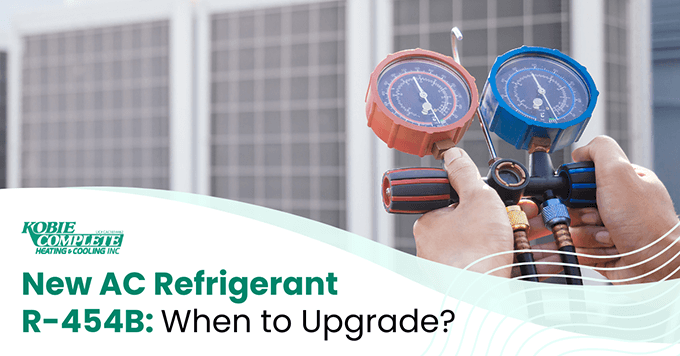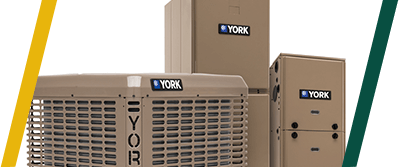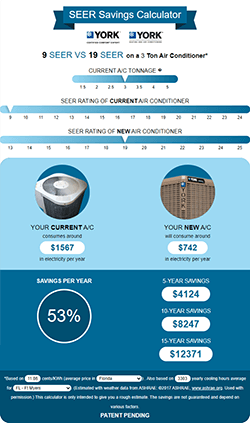
In recent years, there have been a series of new regulations for residential and commercial AC equipment. These new rules are shifting the industry toward more energy efficient and eco-friendly heating and cooling solutions. Sure, being kinder to the environment will benefit us all in the long term. However, updated requirements mean changes to AC system design and manufacturing, resulting in higher equipment prices for you, the consumer.
The newest regulation is no different. It involves a phase-out of R-410A, the industry standard refrigerant. Already, AC manufacturers are racing to roll out upgraded equipment to comply with the new standard.
So, let’s dive into the details on this refrigerant change. In addition to explaining what is happening and why, we’ll also explore how the changes will affect you as a homeowner. Then, we’ll give you our expert advice on when to upgrade your AC system.
Understanding the R-410A Refrigerant Phase-Out and the Switch to R-454B
Background
In 2020, Congress approved the American Innovation and Manufacturing (AIM) Act, limiting the production of hydrofluorocarbons (HFCs) based on their Global Warming Potential (GWP).
GWP measures a substance’s climate warming impact compared with CO2. According to the GWP rating scale, HFC emissions can be hundreds or even thousands of times more harmful than emissions from carbon dioxide.
The refrigerant R-410A, used in home and commercial AC systems, is an HFC. R-410A has been the industry standard ever since it replaced the banned, ozone-depleting refrigerant R-22 (Freon). Though not ozone-depleting, R-410A has a higher GWP rating than R-22.
Limitations and Deadlines
Because of this, the EPA under the AIM Act has begun limiting the production of R-410A and other HFCs exceeding a certain GWP limit, first by 10% in 2020, and now by an additional 30% in 2024. Additionally, they have required all HVAC manufacturers to stop producing all new AC and heat pump systems containing R-410A by January 1, 2025.
R-454B: The New Standard AC Refrigerant
Most HVAC manufacturers (among them Johnson Controls, Lennox, Trane, and Carrier) have decided to adopt R-454B (also known as Opteon™ XL41) as the new standard refrigerant to replace R-410A.
R-454B’s global warming potential (GWP) rating is 78% lower than R-410A’s and far below the EPA’s limit of 700 GWP. Also, in the testing phases, the new refrigerant behaved very similar to R-410A. This will reduce the learning curve for AC companies like us. Also, Daikin1 and Carrier2 estimate that R-454B is between 2-3% more energy efficient than R-410A, which is good news for the environment and your electricity bill.
Mild Flammability: The Eco-Friendly Tradeoff
Despite all the positives with the new refrigerant, there is a downside. To achieve a low enough GWP, the new refrigerant had to be slightly more flammable than R-410A. So, how flammable is R-454B, and should you be concerned?
To put things in perspective, all refrigerants are flammable. Some are just more flammable than others. For example, R-410A carries an A1 rating on the American Society of Heating, Refrigerating and Air-Conditioning Engineers’ (ASHRAE) flammability and toxicity scale. On that scale, R-454B is rated A2L. Figure 1 below shows how the flammability ratings relate to one another. As you can see, A2L is only one step more flammable than A1.
Figure 1: ASHRAE Refrigerant Safety Group Classification3
| Lower toxicity | Higher toxicity | |
|---|---|---|
| Higher Flammability | A3 | B3 |
| Flammable | A2 | B2 |
| Lower Flammability | A2L | B2L |
| No flame propagation | A1 | B1 |
If you don’t find that reassuring, you can watch this informational YouTube video, where a representative from The ESCO Institute tests and compares how A1, A2, A2L, and A3 rated refrigerants react when exposed to different ignition sources. The verdict? An A2L substance can only ignite under very specific conditions and is only slightly more likely to catch fire than an A1 substance.
As a precaution, all our technicians are undergoing special training on how to safely handle the new refrigerant.
How the New Refrigerant Requirements Affect You
New Equipment Designs Result in Consumer Price Increases
Unfortunately, there is no retrofit scenario which would allow current AC systems to use the new refrigerant. This means that HVAC equipment currently on the market had to be redesigned to use R-454B.
Because of the manufacturer’s increase in costs associated with the redesign, new AC systems will be 15% more expensive than systems currently available.
Are You Required to Upgrade Your Air Conditioner?
So, does all this mean you have to upgrade your AC system to one that uses the new refrigerant? The answer is not right away. You are allowed to keep your current air conditioner, no matter what refrigerant it uses, for the duration of its serviceable life.
Manufacturers are technically allowed to continue producing AC equipment using the old refrigerant until 2025. Any equipment produced before that deadline must be installed by January 1, 2026. However, wanting to avoid stranded inventory, the manufacturers are scaling back production of outdated equipment well ahead of those deadlines. In fact, they have started releasing their new, redesigned AC systems now. At the time of the writing of this post, we at Kobie Complete Heating & Cooling just received our first shipment of equipment using the new R-454B refrigerant.
Also important to note: HVAC companies like us will be allowed to service and repair air conditioners with R-410A refrigerant for the foreseeable future. However, certain components as well as refrigerant for recharges will become scarcer with decreased production.
Our Expert Advice on the Best Time to Buy a New Air Conditioner:
- If your AC system is over 10 years old and you’re considering an upgrade, we recommend purchasing a new air conditioner with the old standard R-410A refrigerant before July 1, 2024. There are a few reasons for this:
- First, your AC will cost you about 15% less than a similar model with the new refrigerant.
- Second, after July 2024, R-410A models are going to become more difficult, if not impossible, to find due to production scale-downs.
- You can have peace of mind in knowing that the R-410A refrigerant is “tried and true”. We advise a wait-and-see approach, giving the industry time to adapt to the new R-454B refrigerant (and shake out any bugs should they occur).
- Finally, you can still enjoy all the benefits of a new AC system, like increased energy efficiency and reliability, compared to your old AC.
- If your AC is under 10 years old, you’re happy with its performance, and you’re still expecting many years of serviceable life from it, then we recommend waiting to upgrade until it becomes necessary to do so. By the time you need a new AC, the R-454B refrigerant won’t be so new anymore and hopefully any kinks will have been resolved. To make sure your current system lasts as long as possible, be sure to keep up with regular maintenance (and consider a planned maintenance agreement).
This is our best advice based on over 20 years of experience in the HVAC industry. Of course, if you are excited about the environmental benefits of the new refrigerant and the cost is not an object, then consider upgrading to the new, R-454B compatible air conditioning models as soon as you want. As we mentioned, we already have some of the new units in stock. We’ll be happy to install one for you!
Let’s Chat About the Future of Your Home Comfort
At Kobie Complete, we are committed to helping you navigate the changes to home AC systems. If you live in Sarasota or Charlotte County, Florida, we invite you to contact us for a consultation and quote on a new AC system for your home. We are here to guide you to make the best HVAC decisions for your lifestyle and budget.
Get a Free AC Replacement Quote
Kobie Complete’s service area spans from Sarasota to Punta Gorda. Live in Sarasota and Charlotte County? Fill out the form below or call us at (941) 474-3691 to get a free, no-obligation quote on a new air conditioner installation.
Sources:
“2024 Brings Sweeping Changes to the HVACR Industry”, Joanna R. Turpin, ACHR News, January 2, 2024, https://www.achrnews.com/blogs/17-opinions/post/153990-2024-brings-sweeping-changes-to-the-hvacr-industry. Accessed April 9, 2024.
“TRANSITIONING TO LOW-GWP ALTERNATIVES in Residential and Commercial Air Conditioning and Chillers”, United States Environmental Protection Agency (EPA) Significant New Alternatives Policy (SNAP), December 2016, https://www.epa.gov/sites/default/files/2021-02/documents/transitioning_to_low-gwp_alternatives_in_res_and_com_ac_chillers.pdf. Accessed April 8, 2024.
“Behind the Low-GWP Refrigerant Transition: R-454B and A2Ls”, Johnson Controls, https://www.johnsoncontrols.com/navigating-the-refrigerant-transition. Accessed April 9, 2024.
“Technology Transitions Program Fact Sheet”, United States Environmental Protection Agency (EPA), December 2023. https://www.epa.gov/system/files/documents/2023-10/technology-transitions-final-rule-fact-sheet-2023.pdf. Accessed April 9, 2024.
“Technology Transitions”, United States Environmental Protection Agency (EPA), December 21, 2023. https://www.epa.gov/climate-hfcs-reduction/technology-transitions. Accessed April 9, 2024.
“Substitutes in Residential and Light Commercial Air Conditioning and Heat Pumps”, United States Environmental Protection Agency (EPA) Significant New Alternatives Policy (SNAP), July 17, 2023, https://www.epa.gov/snap/substitutes-residential-and-light-commercial-air-conditioning-and-heat-pumps, Accessed April 9, 2024.
1“The facts about R-32 and R-454B”, R-32, 2022, https://www.r32reasons.com/docs/default-source/default-document-library/the-facts-about-r-32-and-r-454b.pdf. Accessed April 10, 2024.
2“R-454B”, Carrier Air Conditioning and Heating Systems – Europe, https://www.carrier.com/commercial/en/eu/innovation/r-454b/. Accessed April 10, 2024.
“Opteon™ XL41 (R-454B) Refrigerant”, Opteon, https://www.opteon.com/en/products/refrigerants/xl41. Accessed April 10, 2024.
3Based on the chart in “Federal Register / Vol. 88, No. 82 / Friday, April 28, 2023 / Rules and Regulations”, https://www.govinfo.gov/content/pkg/FR-2023-04-28/pdf/2023-08663.pdf
“Are Refrigerants Flammable?-“Did You Know” The ESCO HVAC Show”, YouTube, Uploaded by ESCO Institute-HVAC Excellence, Jul 12, 2023, https://youtu.be/MWD9-aykQtc?feature=shared
Legal disclaimer:
Recommendations above are based on current guidance from regulatory bodies but are subject to change. You should make decisions regarding your HVAC system based on your own research.










